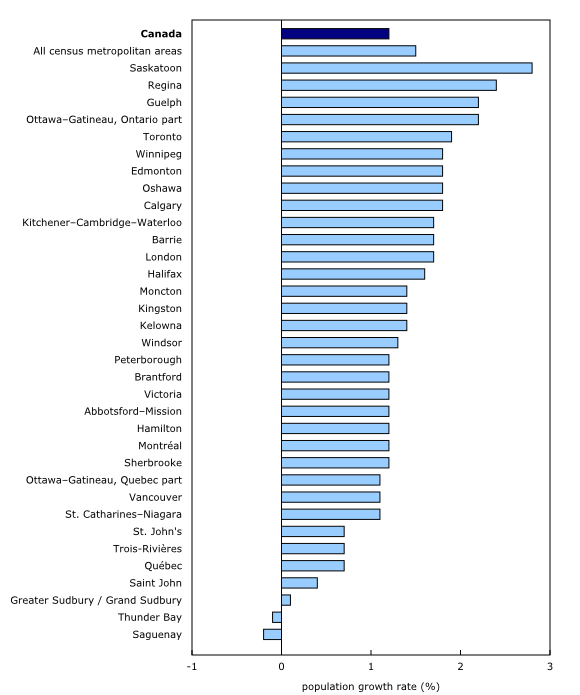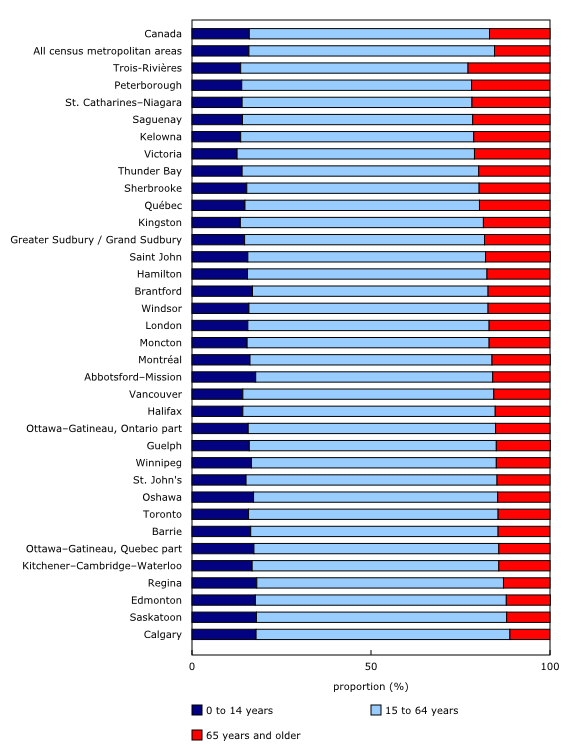Canada's population estimates: Subprovincial areas, July 1, 2017
Archived Content
Information identified as archived is provided for reference, research or recordkeeping purposes. It is not subject to the Government of Canada Web Standards and has not been altered or updated since it was archived. Please "contact us" to request a format other than those available.
Released: 2018-02-13
On July 1, 2017, 7 in 10 Canadians (70.5%), or 25,893,686 people, were living in a census metropolitan area (CMA). Canada's three largest CMAs—Toronto, Montréal and Vancouver—were home to more than 1 in 3 Canadians (35.6%).
From July 1, 2016 to June 30, 2017 (2016/2017), population growth was three times higher in CMAs (+1.5%) than in areas outside of the CMAs (+0.5%). Population growth in the CMAs in 2016/2017 was comparable with the growth in 2015/2016.
These findings are from the publication Annual Demographic Estimates: Subprovincial Areas, which was updated today.
The population is growing faster in the Prairie census metropolitan areas and in some Ontario census metropolitan areas
The 10 CMAs with the highest population growth in 2016/2017 were in either the Prairies or Ontario. In 2016/2017, the population growth rate was 2.0% or higher in four CMAs: Saskatoon (+2.8%), Regina (+2.4%), Guelph (+2.2%) and Ottawa–Gatineau (Ontario part) (+2.2%). These were followed by the CMAs of Toronto (+1.9%), Oshawa, Winnipeg, Edmonton and Calgary (+1.8% each), and Kitchener–Cambridge–Waterloo (+1.7%).
This was the first time since 2009/2010 that neither Calgary nor Edmonton was among the top five CMAs with the strongest population growth in Canada. The population growth of CMAs in Alberta has been lower since 2013/2014, coinciding with the commodities downturn that began in 2014. This downturn was also associated with the rising unemployment rate in the province from the beginning of 2015, which reached a peak at the end of 2016.
The population growth rates in the Guelph, Toronto, and Ottawa–Gatineau (Ontario part) CMAs in 2016/2017 were the highest seen in the past 15 years. International migration was the main driver of growth in the Toronto and Ottawa–Gatineau (Ontario part) CMAs, while it contributed to a sizeable portion of the population increase in the Guelph CMA.
The population decreased in the Saguenay (-0.2%) and Thunder Bay (-0.1%) CMAs for the fourth consecutive year. The Saguenay CMA population decrease was partly attributable to recurring losses of young adults aged 18 to 24 years leaving the CMA to live elsewhere in Quebec. In Thunder Bay, the number of deaths surpassed the number of births, and has done so since 2006/2007, contributing to its population decline.
Population growth also varied in areas outside of the CMAs. In 2016/2017, population growth in Prince Edward Island (a province with no CMAs) was 1.7%, the highest growth rate for an area outside of a CMA.
Population decreases were recorded in the non-CMA parts of Newfoundland and Labrador (-1.0%), Nova Scotia (-0.3%), New Brunswick (-0.1%) and Alberta (-0.1%). The population of the non-CMA part of Alberta fell for the second consecutive year, following a period of growth that lasted until 2014/2015. The population decrease in the non-CMA parts of three Atlantic provinces marks the continuation of a long-term trend.
International migration remains the main driver of growth of census metropolitan areas
The international migratory increase in CMAs continued to grow in 2016/2017. The international migration growth rate (+1.2%) in Canadian CMAs was the highest seen in the past 15 years. International migration remains the main contributor to the population growth of CMAs (accounting for 78% of total population growth), up from 75% in 2015/2016.
The international migration growth rate increased in most CMAs, excluding CMAs in the Atlantic and Prairie provinces, where it was relatively stable. Despite not increasing, the international migration growth rate of the majority of CMAs in the Prairies was among the 10 highest in Canada. The Regina CMA had the highest international migration growth rate (+2.1%) among all CMAs in Canada for a second consecutive year.
In absolute numbers, the highest international migration growth was once again recorded in the Toronto (+113,074), Montréal (+52,158) and Vancouver (+31,541) CMAs.
The number of non-permanent residents rose significantly, especially in Ontario CMAs and in Canada's three largest CMAs, with values rarely or never seen in the observation period from 2001 to 2017. In 2016/2017, Canada recorded a significant increase in the number of study permit holders and work permit holders, notably in Ontario.
Interprovincial migration is a driver of growth in several census metropolitan areas in Ontario and British Columbia
Although interprovincial migration did not contribute significantly to population growth in most CMAs in 2016/2017, it was a source of growth in several CMAs in Ontario and British Columbia. The Kelowna CMA (+1.0%) had the highest interprovincial migration rate in Canada, followed by Victoria (+0.7%). In Ontario, 9 of 15 CMAs posted positive interprovincial migration rates ranging from 0.1% to 0.6%.
Conversely, negative net interprovincial migration in the St. John's, Winnipeg, Regina and Saskatoon CMAs (-0.6% for each) was proportionally the highest in Canada. In addition, interprovincial migration rates in the Calgary (-0.3%) and Edmonton (-0.2%) CMAs were negative for the second consecutive year, following five years of gains.
Largest census metropolitan areas losing some population to neighbouring areas
In 2016/2017, Canada's three largest CMAs continued to post sustained population growth. However, these CMAs also recorded losses due to migration within their own province: Toronto (-36,755), Montréal (-10,325) and Vancouver (-9,926). This migration was mainly to the areas neighbouring these CMAs. The Toronto CMA saw large migration losses that benefitted the neighbouring CMAs of Oshawa, Hamilton and Barrie.
The populations of census metropolitan areas are generally younger
On July 1, 2017, the median age for the population residing in a CMA was 39.4 years, compared with 44.3 years for the non-CMA population. The proportion of people aged 65 and older was lower in CMAs (15.5%) than in areas outside of the CMAs (20.1%).
The number of people aged 65 years and older exceeded the number of children aged 0 to 14 years in Canada in 2014/2015. By July 1, 2017, just over 40% of CMAs had more children than seniors.
Trois-Rivières was the CMA with the highest median age (46.3 years) and the highest proportion of seniors aged 65 and older (22.9%). Conversely, the Saskatoon CMA had the lowest median age (34.9 years), while the Calgary CMA had the lowest proportion of seniors aged 65 and older (11.1%). The Regina CMA had the highest proportion of children aged 0 to 14 years (18.1%).
Population also aging in census metropolitan areas
Although the CMA population is generally younger, it is also aging. From July 1, 2007 to July 1, 2017, the proportion of people aged 65 and older in CMAs rose 2.9 percentage points to 15.5%. During the same period, this proportion increased 4.8 percentage points in areas outside of the CMAs, to 20.1% in 2017.
The median age of the CMA population also increased over the past 10 years, from 38.2 years in 2007 to 39.4 years in 2017 (+1.2 years). In comparison, the increase in median age outside of the CMAs was more than twice as large, with the median age rising 2.7 years to 44.3 years in 2017.
Faster population aging in areas outside of the CMAs is often correlated with the migration of young adults out of these areas. Generally speaking, more young adults leave areas outside of the CMAs to live in CMAs than the opposite. Pursuing postsecondary education and joining the labour market are the main reasons for these movements.
Note to readers
This release focuses mainly on preliminary postcensal population estimates for census metropolitan areas (CMAs) by age and sex as of July 1, 2017. Revised estimates as of July 1, for the years 2013 to 2016, are also available. Population estimates are also released for census divisions and economic regions.
The estimates in this release are subject to revision. Future updates could affect the trends observed and analyzed in this release.
Estimates by age and sex in this release are based on 2011 Census counts adjusted for census net undercoverage and incompletely enumerated Indian reserves, to which we add the estimated demographic growth from May 10, 2011, to the estimate date. These estimates are based on the 2011 Standard Geographical Classification.
These estimates are not to be confused with the 2016 Census population counts that were released on February 8, 2017. The population estimates by age and sex for subprovincial areas in Canada based on 2016 Census counts adjusted for census net undercoverage and incompletely enumerated Indian reserves will be released in March 2019.
The annual period of reference is comprised between July 1 of a certain year and July 1 of the following year. Therefore, 2016/2017 refers to the period from July 1, 2016 to July 1, 2017.
Population growth rates are calculated using the average of the populations at the beginning and end of the period as a denominator. A rate higher than -0.1% and lower than 0.1% is considered not significant.
A census metropolitan area is formed by one or more adjacent municipalities centred on a population centre (known as the core). A CMA must have a total population of at least 100,000, of which 50,000 or more must live in the core. To be included in the CMA, other adjacent municipalities must have a high degree of integration with the core, as measured by commuting flows derived from census place of work data.
The Ottawa–Gatineau CMA is divided into two parts to distinguish its Ontario and Quebec parts.
Products
The publication Annual Demographic Estimates: Subprovincial Areas, July 1, 2017 (91-214-X), is now available.
Contact information
For more information, or to enquire about the concepts, methods or data quality of this release, contact us (toll-free 1-800-263-1136; 514-283-8300; STATCAN.infostats-infostats.STATCAN@canada.ca) or Media Relations (613-951-4636; STATCAN.mediahotline-ligneinfomedias.STATCAN@canada.ca).
- Date modified:




